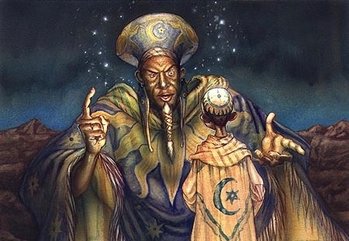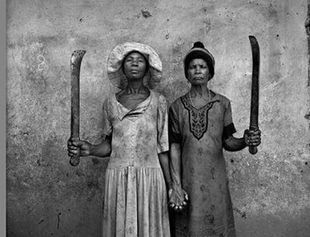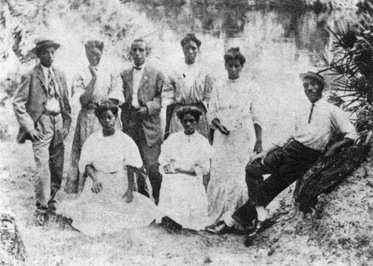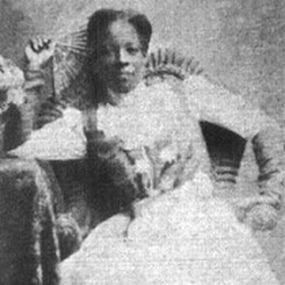One of the biggest challenges for modern-day Orisha worshippers living in the United States or other parts of the developed world is to resist the urge to interpret ancient religions through a contemporary lens. The Lucumi religion, for example, has roots in West Africa that go back thousands of years. It has been filtered through centuries of colonialism in Cuba. It has tinges of paternalism, machismo and homophobia that are politically incorrect today but reflect social conditions and cultural practices from earlier times. In some ways, our religious practices have evolved over time to reflect a changing society, but some ideas are deeply embedded in our belief system and can't be dismantled without seriously challenging the very foundations of our religion. Issues related to gender identity are among the most problematic for this reason.
Archetypes have a symbolic role
 Archetypes teach us about human relations
Archetypes teach us about human relations Ancient people understood the importance of archetypes to represent different facets of the human experience. An archetype is much more than a stereotype. It speaks a kind of universal truth about the human condition. Each archetype can represent a different moment in a human's life, a different set of characteristics or personality traits found among people in a community, symbolic situations that mark moments in human development, and so on. These figures appear in folklore, mythology, and are embedded into different world religions because they reflect ideas that are shared by humans around the world, regardless of cultural specifics. Some examples are the nurturing (earth) mother, the wise old man, the magician, the hero, the seductress, the hermit, the traveler, the joker, the witch, and so on. Usually, these archetypes are presented with gendered identity that reflect either the biological roles of females and males (mother and father, son and daughter, etc.) or cultural ideas about the social roles people play. To some extent, the way the orishas have been personified in our patakis (myths) reflect standard archetypes, such as Elegua the trickster, Obatalá the wise old man, Ochosi the hunter, Ogun the iron worker, Changó the seducer of women, Ochun the seductress, Yemayá the great mother and Oya the fierce independent woman with strong character. This is a very simplistic vision of them, of course, and deeper study reveals that there's much more to them than our first impressions. But that's a topic for another day.
Individual humans experience gender in a different way
 Individual identity may not conform to cultural norms
Individual identity may not conform to cultural norms The gender of a given orisha doesn't necessary match the gender of the human being who is chosen as their son or daughter. Ochún can choose a male or female child, just as Changó and all the others can do. Humans often feel a particular affinity for one orisha in particular and hope that divination will reveal them to be the son or daughter of their personal favorite. But the decision is in the hands of the orishas, not humans. When the ceremony is done to determine who owns the head of a person, the orishas will speak up to claim someone. A man might initially be disappointed to learn that he's the son of Ochún if he secretly hoped he would be chosen by Changó. He mistakenly thinks that Ochún's association with femininity means he's less manly than he imagines himself to be. That's not the case at all. Strong, powerful men can be chosen by Ochún as her sons. She doesn't make them more feminine, but she may grace them with musical or artistic talent, a love of culture and refined things, or the gift of persuasion and seduction. In a similar way, a woman chosen by Changó to be his daughter is not necessarily going to appear masculine. She will, however, have a passionate nature, a strong personality, and a love of rhythm and dance. The cultural associations that we put on different activities, labeling them male or female, are somewhat arbitrary, and the individual can manifest masculine or feminine traits while still being true to the nature of that orisha's energy. Some orishas, like Obatalá, will have masculine and feminine "roads" or "paths," so Obatalá can appear in either form and can be either the father or the mother of a human being. The main idea we need to remember here is that when we speak about the orishas as if they were human, we are merely personifying them, creating images of them in human form based on the stories we know about them. However they are not limited to human form the way we are. They exist in the universe as divine energy, and they transcend gender.
Most people today like to think of themselves as individuals, and they don't want to associate too closely with a particular archetype because, of course, there are always some points where the comparison breaks down and feels incomplete. No one wants to be reduced to one simple role in society, or be defined by one simple trait. At the same time, most people today challenge the idea that they're defined by gender. Gender and sexuality are fluid, and don't always follow socially prescribed roles. Sometimes an individual doesn't identify with his or her biologically defined gender and resists the idea that men must do one thing and women do another in some of our ceremonies. For example, women are supposed to turn their back when someone throws obi to eggun (a divination process done to communicate with the spirits of ancestors). The reasons for this are explained in a pataki, and it's an established tradition in most Lucumi houses. It doesn't mean that women are inferior or lesser than men. It means that that men face one way and women face another way during the ceremony, but neither position is superior to the other; they are merely different, reflecting the fact that men and women are biologically different from one another. Some people resist this kind of binary opposition and feel that they should not be defined on the basis of gender. They want to impose 21st century thinking on an ancient idea because they feel uncomfortable with that way of dealing with gendered identity and feel it limits them in some way. Conversations around these topics can become very heated and lead to major disagreements between those who say tradition must be respected versus those who demand changes be made.
Most people today like to think of themselves as individuals, and they don't want to associate too closely with a particular archetype because, of course, there are always some points where the comparison breaks down and feels incomplete. No one wants to be reduced to one simple role in society, or be defined by one simple trait. At the same time, most people today challenge the idea that they're defined by gender. Gender and sexuality are fluid, and don't always follow socially prescribed roles. Sometimes an individual doesn't identify with his or her biologically defined gender and resists the idea that men must do one thing and women do another in some of our ceremonies. For example, women are supposed to turn their back when someone throws obi to eggun (a divination process done to communicate with the spirits of ancestors). The reasons for this are explained in a pataki, and it's an established tradition in most Lucumi houses. It doesn't mean that women are inferior or lesser than men. It means that that men face one way and women face another way during the ceremony, but neither position is superior to the other; they are merely different, reflecting the fact that men and women are biologically different from one another. Some people resist this kind of binary opposition and feel that they should not be defined on the basis of gender. They want to impose 21st century thinking on an ancient idea because they feel uncomfortable with that way of dealing with gendered identity and feel it limits them in some way. Conversations around these topics can become very heated and lead to major disagreements between those who say tradition must be respected versus those who demand changes be made.
Why not throw out old-fashioned ideas?
 Honoring tradition is a way to honor the ancestors
Honoring tradition is a way to honor the ancestors Another topic that causes bad feelings among some people in the Orisha community is the belief that only men can occupy certain roles or have certain functions in the religion. For example, in the Lucumi tradition, only heterosexual males are allowed to become babalawos. Only men are supposed to play consecrated drums at ceremonies. In most Cuban communities, the obbá (leader of religious ceremonies) is male. Some of these practices and customs are explained through interpretation of odu and patakis, and some are explained in social and historical terms. In a religion where hierarchy matters and the number of years in the priesthood carries significant weight, people who are relatively new to the religion may not be very successful in convincing their elders to change their ways. Over time, if the house is not dysfunctional and good communication exists, some compromises might be worked out between individuals if there is a pressing need for them. Or, the individual might decide to leave the house where he or she was crowned and look for a group that's more sympathetic to new ideas. Sometimes the individual will come to understand that the traditions exist for a reason and they're not necessarily a bad thing. Women and gay men may not be chosen by Orula (to be a babalawo) but they will be chosen by one of the other Orishas with whom they are more in tune, and as a priest or priestess of Yemayá, Obatalá, Eleguá, Oshún, Changó, or any of the others, they can be very powerful and successful religious leaders. How people negotiate these different options will vary a great deal from one person to another.
Those who were raised in the religion and come from Cuban culture usually don't have any problem accepting the religion as it is, and the traditions and customs don't bother then, regardless of their personal opinions about gendered roles. I've never heard anyone in Cuba complain that women are "less" than men in the religion or that women are limited in terms of how much aché (spiritual energy) they have. Some of the most respected and revered elders in my community are women, and their authority isn't challenged by anyone, male or female. They embrace the role that they believe is their destiny (as determined through divination and guidance from the spirit of the ancestors and the orishas themselves). We have proverbs and stories that teach us about the importance of defining ourselves clearly, not being ambiguous about our place in the world or in the community. Sometimes, these break down along archetypical or symbolic roles, or biological identities. Men do one thing, women do another. There will always be individuals who don't fall neatly into a category, or who reject this way of thinking about human beings. Nevertheless, many ancient religions are based on the idea that the world is made up of opposing energy forces, such as hot and cold, life and death, good and evil, blessings and obstacles. The conceptualization of male and female energy in the religion functions in the same way. They are different energies, different forces, and both are necessary (for reproduction and continuation of the human race). Some individuals may decide they don't want children and reproduction isn't an issue for them. They don't want to be defined by their ability to have children. However, this doesn't mean the archetypes of mother/ father or son/daughter cease to have meaning at the societal level. Recognition of gender difference is, if nothing else, recognition of our parents and grandparents and their grandparents, without whom we would not be on earth.
Those who were raised in the religion and come from Cuban culture usually don't have any problem accepting the religion as it is, and the traditions and customs don't bother then, regardless of their personal opinions about gendered roles. I've never heard anyone in Cuba complain that women are "less" than men in the religion or that women are limited in terms of how much aché (spiritual energy) they have. Some of the most respected and revered elders in my community are women, and their authority isn't challenged by anyone, male or female. They embrace the role that they believe is their destiny (as determined through divination and guidance from the spirit of the ancestors and the orishas themselves). We have proverbs and stories that teach us about the importance of defining ourselves clearly, not being ambiguous about our place in the world or in the community. Sometimes, these break down along archetypical or symbolic roles, or biological identities. Men do one thing, women do another. There will always be individuals who don't fall neatly into a category, or who reject this way of thinking about human beings. Nevertheless, many ancient religions are based on the idea that the world is made up of opposing energy forces, such as hot and cold, life and death, good and evil, blessings and obstacles. The conceptualization of male and female energy in the religion functions in the same way. They are different energies, different forces, and both are necessary (for reproduction and continuation of the human race). Some individuals may decide they don't want children and reproduction isn't an issue for them. They don't want to be defined by their ability to have children. However, this doesn't mean the archetypes of mother/ father or son/daughter cease to have meaning at the societal level. Recognition of gender difference is, if nothing else, recognition of our parents and grandparents and their grandparents, without whom we would not be on earth.
Gendered identity is complex and multi-layered
 Susana Cantero around 1910, one of the most powerful santeras in Cuba
Susana Cantero around 1910, one of the most powerful santeras in Cuba As a religious system, we're capable of change, but it comes slowly and with a great deal of thought. Sometimes, people are anxious to throw out old traditions simply because they don't understand them. No one ever explained why something is the way it is, so it's natural to assume there's no reason. Sometimes there is a reason, but we just don't know it. Sometimes in order to understand the reason, we have to learn to think in different ways. We may have to make cultural adjustments, or acknowledge the experience and wisdom of ancient people who had ideas very different than our own. They aren't automatically wrong just because they're different. What has worked well for hundreds of years shouldn't be casually dismissed, even it goes against the grain of our modern thinking. It's possible to think about gendered identity in the religious context one way, and think about it a totally different way in the context of our private lives as individuals. This isn't hypocrisy, but recognition that the world is more complex than any one system of thought might suggest. In the Ocha room, I wear a skirt because that's what's expected of me; in the street, I wear pants because that's what I choose to do. I accept the imposition of wearing a skirt out of respect for my elders and their traditions. I also understand the metaphysical reasons women are supposed to do this. It doesn't mean I have to wear a skirt everywhere I go, or that my freedom has been taken away from me.
These issues can be a real struggle for some people, and as a community, we need to examine more closely why we do what we do, and why we think as we do. We need to learn to think about things in an historical, cultural and social context, and understand the thinking of our elders from their point of view. Maybe we agree with them, and maybe we don't, but before we dismiss ideas as being old-fashioned and wrong, we need to have a more profound understanding of where those ideas came from. We need to understand that traditions aren't rules that are meant to limit our freedom as individuals, but rather, to bring us together as a community, to build collective spiritual energy. Honoring our traditions and our past is part of what we do. We aren't blind to the need to adapt our customs over time, but those who are too quick to change their customs often end up in a confused state because they lose their connection to the collective whole.
These issues can be a real struggle for some people, and as a community, we need to examine more closely why we do what we do, and why we think as we do. We need to learn to think about things in an historical, cultural and social context, and understand the thinking of our elders from their point of view. Maybe we agree with them, and maybe we don't, but before we dismiss ideas as being old-fashioned and wrong, we need to have a more profound understanding of where those ideas came from. We need to understand that traditions aren't rules that are meant to limit our freedom as individuals, but rather, to bring us together as a community, to build collective spiritual energy. Honoring our traditions and our past is part of what we do. We aren't blind to the need to adapt our customs over time, but those who are too quick to change their customs often end up in a confused state because they lose their connection to the collective whole.
 RSS Feed
RSS Feed
